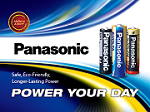According to the European Battery Directive, 2006/66/EC, there are specific labeling requirements for the indication of capacity rating and battery performance for the various battery types.
Batteries are categorized into several types by the design application and technology design: portable primary general purpose battery, portable secondary battery, automotive battery, li-ion battery and watch battery.
Portable Primary General Purpose Battery
A portable, primary, general-purpose battery is a non-rechargeable battery that is not designed for a specific application device and is most commonly composed of various chemistries such as alkaline, manganese, zinc carbon, lithium, zinc-air, silver oxide, nickel oxyhydroxide and lithium iron disulfide. Due to the nature of a general-purpose battery, the capacity of this type of battery is measured by its "performance" which follows testing methods according to IEC/EN 60086. For best product comparison purposes, it is suggested to select 4 of the most relevant applicable tests that the battery geometry is made for. The performance rating can be represented by the duration of discharge in hours or by the number of pulses, for example, the number of flashes for a camera.
Portable Secondary Battery
A portable secondary battery is a rechargeable battery that is designed for a specific application device which is most commonly composed of various chemistries such as nickel cadmium, nickel metal hydride, lithium-ion, lithium polymer and lead-acid. Secondary batteries are tested according to the IEC/EN 60622, 61951, 61056 and/or 61960 standards to provide a good basis for the rating of a battery's capacity in mAh or Ah.
Automotive Battery
An automotive battery is a lead acid battery that is designed as a power source in automotive vehicles for starting the internal combustion engine. The testing method for automotive batteries is defined by the IEC/EN 60095 standard. The capacity of the battery is indicated by Ah and the ability to start an engine in cold climates, "Cold Cranking Amperes" (CCA).
Lithium Ion Battery
Li-ion Batteries are used in many different electronics and electrical devices, including mobiles, laptops, tablets, power tools and electric vehicles. Safety and certification testing of li-ion batteries addresses the handling and charging conditions of lithium-ion batteries, as well as testing cells against extreme temperatures, voltages and currents.
Watch and Specialty Battery
For watch and speciality batteries, there are no harmonized tests suggested. Testing according to existing standards will be most appropriate. For example, watch batteries can be tested according to method A of IEC/EN 60086-3 standard which provides meaningful data on the performance of the battery.
Button Cell and Coin Battery
After the enactment of Reese's Law in 2022, the U.S. Consumer Product Safety Commission (CPSC) has approved the rule 16 CFR 1263 outlining the requirements for consumer products containing button cell or coin batteries. Consumer products containing button cell or coin batteries are required to comply with ANSI/UL 4200A-2023.
Energy Storage and Battery Products Testing Service:
We provide testing for the following product types, systems and applications:
- AA, AAA, C & D Batteries
- Battery packs
- Chargers
- Coin & Button Cell Batteries
- Flow Batteries
- Fuel Cells
- Electric Vehicles (EV)
- Electric Vehicles Supply Equipment (EVSE)
- In-Device Testing
- MP3, Cell Phone & Laptop Batteries
- Pack controllers 9V & 12V Batteries
- Primary Battery Systems (Alkaline, Lithium)
- Redox Batteries
- Secondary Battery Systems (Rechargeable, Lithium-Ion)
- Service Disconnects
- Super Capacitors
- Wire Harnesses


